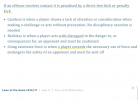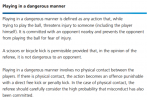A long time ago when I was being observed I awarded an IDFK for "playing in a dangerous manner". It was a classic high foot. There was very light contact with the opponent, but I didn't think it merited being called a kick or trip.
My observer told me it can't be indirect if there's contact and I've lived by that rule ever since.
However, I can't actually find anything in the laws to support this view, have I missed something?
My observer told me it can't be indirect if there's contact and I've lived by that rule ever since.
However, I can't actually find anything in the laws to support this view, have I missed something?





 A player who carelessly contacted an opponent\ with his foot has kicked the opponent. (Or, if it makes you feel better, you can think of it as carelessly challenging the opponent, which would also be a DFK.) The question for the R is whether that kick was trifling or worthy of calling the foul. What the R can't do is weasel out by calling PIADM. Whether we like it or not, that is the way the Laws are written. If the opponent was not dissuaded from or disadvantaged in challenging the ball, the minimal contact is likely trifling, and there is no foul to call. A high foot is not in and of itself a foul, PIADM or otherwise.
A player who carelessly contacted an opponent\ with his foot has kicked the opponent. (Or, if it makes you feel better, you can think of it as carelessly challenging the opponent, which would also be a DFK.) The question for the R is whether that kick was trifling or worthy of calling the foul. What the R can't do is weasel out by calling PIADM. Whether we like it or not, that is the way the Laws are written. If the opponent was not dissuaded from or disadvantaged in challenging the ball, the minimal contact is likely trifling, and there is no foul to call. A high foot is not in and of itself a foul, PIADM or otherwise.